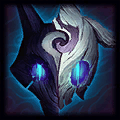

Kindred





Estadísticas y Tasa de Victorias de Kindred
basado en 23.677 partidosCómo analizamos nuestros datos
LoL Kindred Estadísticas y porcentaje de victorias
Tasa de victorias a lo largo del tiempo de Kindred
As a result of Kindred's K/D/A and utility, they have a somewhat poor overall win rate. They do very well in the late game, with a winrate of 51.7% in that phase. Unfortunately, they do worst in the mid game, where Kindred's win rate is 48.5%., The difference between their best and worst game phases is about 3.2%. This sizeable difference indicates that their power spikes and wanes in different phases of the round. Plan accordingly.
Estilo de juego de Kindred
Tipos de daño de Kindred
La Leyenda de Kindred
Estadísticas base de Kindred
Estadísticas de Kindred frente a otros marksman

Resumen de las estadísticas de Kindred (continuación)
In the current meta, Kindred is somewhat popular. They have been selected in 4.2% of recently ranked games. They are rarely banned during champ select. Obviously, very few players see them as a major threat. In recent ranked games, Kindred was banned 2.3% of the time.
Kindred is most commonly played in the jungle position. This happens in 93,7% of their games. Yet, jungle Kindred has the highest win rate (49,5%) of all positions but is less popular of a position (played 3,1% of the time). Currently, Kindred's meta game is focused on dealing damage. In particular, their build should mostly be focused on physical damage. Dealing magical damage is the least important part of Kindred’s gameplay.
You should anticipate having to dedicate only a little bit of time practicing and learning to pick up Kindred. Most League of Legends gamers think they are a simple champ to get good at. Kindred primarily deals physical damage (74% of their total damage). They doesn't deal a lot of other damage types and should not be considered a hybrid damage dealer..
Kindred deals a decent amount of damage during a regular ranked match (19.436 damage). You may want to focus on developing them as a damage dealing champ to destroy your enemies.
They are a powerful damage dealer on the Rift with 6.6 kills on average each game. That is one of the highest kill rates amongst all jungles. Additionally, they have a relatively high average champion death count (6.9 deaths). Additionally, Kindred's KDA is usually low with an average KDA ratio of 2.0 as well as 7.3 assists per game.
additionalInformation
method2.title
method2.text1
method2.text2
method2.text3
method2.text4